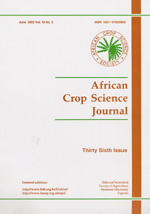
|
African Crop Science Journal
African Crop Science Society
ISSN: 1021-9730
EISSN: 1021-9730
Vol. 8, No. 1, 2000, pp. 1-10
|
 Bioline Code: cs00001
Bioline Code: cs00001
Full paper language: English
Document type: Research Article
Document available free of charge
|
|
|
African Crop Science Journal, Vol. 8, No. 1, 2000, pp. 1-10
| en |
Genotype X Environment Interaction and Optimum Resource Allocation for Yield and Yield Componenets of Cassava
Dixon, A.G.O. & Nukenine, E.N.
Abstract
Dry yield and yield components from 6 multilocational trials of cassava genotypes
conducted for 3 years in Nigeria were used to study the nature and magnitude of genotype x
environment (G x E) interaction and to determine the optimum resource allocation for
cassava yield trials. The effects of environment, genotype and G x E interaction were highly
significant for all yield traits. Variations due to G x E interaction were greater than those due
to genotypic differences for all yield traits. Genotype x location x year interactions
contributed most to the G x E interaction for all the yield traits. Therefore, to facilitate
selection, zonation of cassava growing agroecologies into homogenous ecosystems using
multivariate statistical approach should be done to minimise the influence of the G x E
interaction. Testing at 3-5 locations for 2-3 years with 3-4 replications per location is the
optimum combination that will not jeopardise precision in cassava yield trials.
Keywords
Manihot esculenta, Nigeria, yield stability
|
| |
| fr |
Dixon, A.G.O. & Nukenine, E.N.
Résumé
Le rendement sec et les composantes du rendement de 6 essais multilocaux de
génotype de manioc menés pendant 3 ans au Nigeria ont été
utilisés pour étudier la nature et la magnitude de linteraction
génotype x environnement (G x E) ainsi que pour déterminer lallocation
optimum des ressource dans des essais de rendement du manioc. Les effets de
lenvironnement, du génotype et de linteraction G x E étaient hautement
significatifs pour tous les caractères du rendement. Linteraction génotype x
localité x année a contribué le plus à linteraction G x E
pour tous les caractères du rendement. Par conséquent, pour minimiser
linfluence de linteraction G x E et ainsi faciliter la sélection, lapproche
statistique multivariée devrait être envisagée dans la zonation des
agroecologies où le manioc est cultivé en écosystème
homogène. Lévaluation dans 3-5 localités pendant 2-3 ans avec 3-4
répétition par localité est la combinaison optimale qui permet une
bonne précision dans les essais de rendement du manioc.
Mots Clés
Manihot esculenta, Nigeria, stabilité du rendement
|
| |
© Copyright 2000 - African Crop Science Society
|
|
